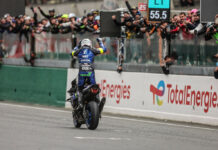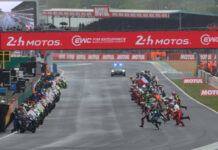FIRST PERSON/OPINION:
By David Swarts
If Daytona Motorsports Group (doing business as AMA Pro Racing) was publicly traded, stock prices would have shot up 1000% on the news that Roger Edmondson has left his position with the company.
According to a press release issued December 30 by AMA Pro Racing, Edmondson left the company for “unforeseen health issues.”
I doubt that Edmondson really left due to “unforeseen health issues;” I think he was kicked out for seriously mismanaging AMA Pro Racing and doing enormous damage to professional motorcycle road racing in this country.
Whatever the true reason for his departure, the fact that Edmondson is no longer the head of AMA Pro Road Racing is the best news I’ve heard in a long time.
In fact it’s the best news the industry has had since the original announcement came that the American Motorcyclist Association (AMA) was selling most of its professional racing properties to Daytona Motorsports Group (DMG).
Then, most in the paddock thought that DMG would elevate motorcycle road racing to the next level. After all, the group was led by Jim France, the Executive Vice President and Vice Chairman of the Board of Directors of NASCAR, the former CEO of International Speedway Corporation (ISC, which owns Daytona International Speedway, Auto Club Speedway and several other large motorsports venues) and the founder of the Grand Am car racing series Edmondson also ran.
The popular perception was that France–and others involved in making NASCAR the success it is today–would apply their know-how and resources into making something big out of motorcycle road racing. Instead, France and his partners seem to have put AMA Pro Road Racing completely in the hands of Edmondson as they went on about their other business.
Unfortunately, Edmondson’s poorly thought-out policies, his disregard for recommendations from experienced staffers, his public assault on the companies and people who have built the series up during the last decade, and his overall mismanagement combined with the global economic recession had dragged the sport into one of its darkest periods as the 2009 season closed, a time when manufacturers and sponsors were pulling support, race promoters were finding it harder to justify paying to bring the AMA show back to their tracks, purses were being dramatically reduced and viable rider turnouts were doubtful for 2010.
Edmondson’s errors were many, including making promises he could not keep. At Laguna Seca in July of 2008, he spoke to me and addressed rumors that the spec tires required in 2009 would cost $450 per set.
“Anybody who thinks we would approve a tire program costing that kind of money doesn’t have any idea what we’re all about and what we’re trying to make happen here,” Edmondson told me.
Technically, he was right: Dunlop spec tires only cost $420 plus tax per set for all AMA classes at Daytona. Tires for the American Superbike class cost $400 plus tax per set and Daytona SportBike tires were $360 per set plus tax for the remainder of the season. A typical rider burned up between $25,000 and $30,000 worth of tires during the 2009 season at races alone, not counting testing. And there were no bonuses or contingency offered by Dunlop for race wins or podiums.
Some things Edmondson told the press can only be called lying. He looked me straight in the eye and told me he absolutely had not delayed announcing that there would be a promoter practice on the Thursday before the race weekend at New Jersey Motorsports Park so teams would feel compelled to participate in a standalone test there a month earlier. In fact, I found out later, Edmondson had tipped at least one team owner that there would be a Thursday promoter practice day and asked him to not tell anyone else about it in order to protect Yamaha’s financial investment in setting up that standalone test.
Sometimes Edmondson’s comments were taken out of context by reporters and readers, but just as often he made comments that were used in context and that were unnecessarily inflammatory, driving a wedge deeper between DMG and every stakeholder in the AMA Pro Road Racing paddock.
For instance, in 2008 AMA Pro Racing issued a statement that the organization would race rain or shine at Mid-Ohio, a track that had been deemed unraceable in the wet by Pro riders due to its sealer-covered racing surface being extraordinarily and inconsistently slippery when wet. At the time, Roadracingworld.com asked members of the AMA Rider Safety Council for Road Racing–including Ben Bostrom, Jamie Hacking, Mat Mladin and Jake Zemke–if they had been consulted in the decision, and they all said they had not.
When I asked if the Rider Safety Council would be irrelevant in the future, Edmondson said, “It’s irrelevant right this minute, as far as I’m concerned. We have not met anybody and nobody’s ever presented themselves as being a member of it. And frankly, I haven’t asked about it in this particular case.”
Of course there was another interview he did on the topic in which he said “riders have a comfort zone the size of a gnat.”
And then there was his epic failure to manage DMG’s at-track staffers, who made mistake after mistake. The Safety Car incident at Mazda Raceway Laguna Seca was not only embarrassing but life-threatening. Some of the mistakes were honest human errors, while others were unbelievably malicious; other mistakes were made by people doing their best to institute Edmondson’s own flawed procedures, like sending out “safety” cars onto the track instead using red flags.
In an interview I did with Edmondson in June of 2008, I asked him: How will we measure the success or lack thereof the changes being implemented by DMG in professional road racing?
“Well, obviously, there’s so many areas that have to be it worked on, it depends on which one you want to measure first,” Edmondson said. “Rider participation will certainly be one, the quality of the TV package, the quality of the schedule both in terms of where we go and if the travel patterns make sense, the integrity of the rules and the enforcement of the rules, and the proper professional relationship between the event staff and the team owners and their crew members. There’s so many areas of measurement I would say you should probably start measuring right after Daytona 2009, because that’s the first race that’s totally ours.”
A strong case can be made that Edmondson–and DMG as a whole–failed miserably on all counts.
So what needs to happen now?
The remaining members of DMG need to immediately take steps to stop the sport’s bleeding and make capital investments to sustain it through these tough times tough times its former point man Edmondson is largely responsible for.
Two manufacturers Honda and Kawasaki — have already pulled their backing of the series which could include advertising during television broadcasts and at the events on top of their obvious withdrawal of support for racing teams. A third manufacturer, Buell, has ceased to exist.
So instead of cutting back the purses, as has been announced, AMA Pro Racing needs to reach into its pockets and restore the race purses to at least the level they were in 2009, if not increase them, in order to keep privateers like Taylor Knapp and David Anthony on the grid and contributing to the show. Otherwise, they risk American Superbike grids of 10 bikes or less.
With little sponsorship available, a purse so small that it can’t cover a typical non-factory rider’s gas to get to the track–let alone their tire bill–and fewer factory rides to aspire to, how and why would privateers bother coming out to race?
I can’t emphasize enough DMG’s need to make capital investments in its own business to sustain it through these tough times.
DMG also needs to get its marketing staff in gear and get our racers in front of people, to promote the sport. Getting the riders on the local news is fine and all, but does anyone remember when the Hayden brothers were on the Tonight Show with Jay Leno or Nicky Hayden was on MTV and in People Magazine? That happened thanks to their own managers and P.R. men, with a little help from Red Bull. If they can get those kind of results, why can’t NASCAR-affiliated DMG get our sport exposed in the mainstream? Even Clear Channel Entertainment tried to cross-promote road racing at Supercross back when it owned Formula USA.
As far as the classes and technical rules are concerned, most everything currently in place is workable. The racing last season was some of the best ever with lots of parity, multiple winners and close action. So this area needs little attention except ensuring that the officials entrusted with implementing the policies and enforcing the rules get clear signals and close supervision.
There are many other improvements needed and good feedback available. DMG needs to talk with the stakeholders of the sport and actually listen to them and take what they say to heart instead of just paying them lip service and carrying on blindly with one man’s crazed agenda.
Thankfully, that one man–Roger Edmondson–is gone, and some hope has been restored to the sport. I just hope that the partners and investors in DMG are paying close attention, because after hitting rock bottom their business’ stock is now on the rise. They’ve got a brief window of opportunity to succeed, and God help us all if they don’t take advantage of that opportunity by doing the right thing.






